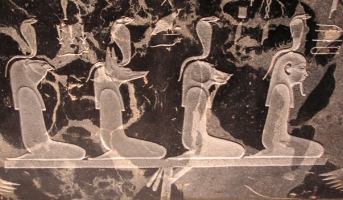The Caduceus and its three (original) elements
Reflectiveness – the wings of imagination and light
The wings of the caduceus in its earliest incarnation were probably ribbons and feathers added to the staff which was handed to a conquering General, during the Roman epoch. When defeated armies sued for peace, the intermediary carried a staff with feathers or ribbons adorning it.
Roman staff; suing for peace
This was handed to the winning side. At around the same time, the staff with Aesculapius’ snakes wrapped around it, appeared with wings in the emblematic staff of both Hermes and Mercury–wings appeared on ankles and hats!
Mercury / Hermes
They turned up in narratives such as Daedalus constructing wings for his son Icarus who fell to his death when he flew too near to the sun (a prelude to Prometheus’ journey). Eagles appeared as winged beasts and ate the liver of Prometheus, whilst chained to a rock. Wild beasts were given feathers to aid in flight or magnify their power, as in Greek versions of the Sphinx and other undifferentiated animal beasts such as the gryphon. Pegasus–the offspring of a similar undifferentiated creature, Medusa (snakes as hair)–was given wings to aid in movement and the ability to fly great distances, over uncharted territory.
Pegasus
Wings signify movement; they hint at moving from an earth-bound territory to an avian niche. They allude to movement so small, and persistent, zipping past our eyes, unseen except out of the corners of our eyes. They infer taking flight in our imagination and flying into unknown territory, where only the limitations of our mind inhibit what we create. They tell us of the muse who flies upwards as an intermediary between gods and man.
Hermes: psychopomp, trickster, orator, patron of thieves and businessmen
The wings of the Caduceus remind us of our earth-bound life and our wish to transcend its limitations. We, humans, can thus mimic what our mythic heroes show us: we can place wings on our ankles and fly, like Hermes down to the underworld, into our subconscious, the pit, our shadows and death, and primitive memories. We can place wings metaphorically on our feelings and fly into gentle lands, of beautiful scenery, flowing brooks, peaceful, serene, where all is wonderful, and these flights of fancy remind us of the faerie lands where senses are dulled or sharpened, coloured and bewitched. Likewise, as Pegasus we can add wings to our backs and fly, belaboured, habitual, into our minds and take flight; over hill and dale, gurgling rivers and foreign lands, only to land on pleasant earth and find that we have viewed the known, simply from a different height. We can add wings to our clever cap and fly as a muse, Mercury bound, and with quicksilver minds etch the future with profound ideas, soft oracles from the mouth of one who knows, or like dear Icarus borrow the imagination of man and fly too close to the sun, and fall to our death.
It is hard for most of us to soar, unfettered, to the heavens as the eagle glides through the thermals. The metaphor of the eagle, so much used in native traditions, especially in the USA, reminds us of a place within each of us, whereby we can see from afar, soar and be free, without strictures, or have our eyes fixed on the kill or target. It is our mental acuity, sharpness of vision, mental freedom, and capacity to hold onto things and not let go.
In our understanding reflectiveness also has several layers of understanding, so we can further delineate our evolution of perception portrayed in the funerary jars of ancient Eygpt, and see that they carry emblems of perception–from seeing afar (the eagle), coming down to the ground and being able to kill off that which is decaying and dead (vulture), allowing our senses to evade capture, premature death and to ensure survival (coyote), to mimic human life and copy what others show us (chimpanzee) and to enable instinctual wisdom and to lead the tribe, community, group, family–the gorilla. These are metamodels (a language to express additional semantics of existing information), present in ancient writing to describe illumination, and the stages we need to develop within us, to truly see.
Sons of Horus; usually applied to funerary jars; undifferentiated humans: falcon, coyote/jackal, baboon, magi
5 levels of perception; eagle; vulture, coyote (fox), chimpanzee, and gorilla
Our word reflectiveness is an attempt to infer both reflexive thought (that which has turned back on itself), and the ability to mirror, to see from afar, to observe, to see both close up and from afar, and to place oneself outside of a situation and see from the third person. In spiritual terms, it alludes to an inner process when the mind is illumined from above–as if some light illumines the mind–both subject and object. In essence, it is Light, as in the scriptural passages of Saul’s conversion when he was struck by the Light and (temporarily) blinded. Also, Nur Mohammed Pbuh, the light of the Prophet, or Nur Isa–the Light of the Christ. These refer to spiritual states, whereby the radiant nature of these humans is so great that their love, wisdom, and understanding may penetrate our consciousness, when ‘hit’ by their light. This transformative may also be nonlocal, for it can occur in a moment, a dream, through transmission, prayer, or by accident.
The following articles relate to the journey:







